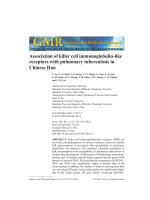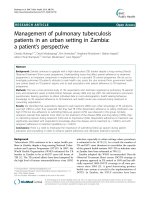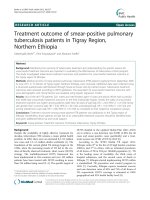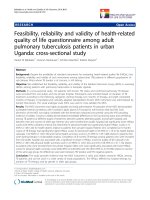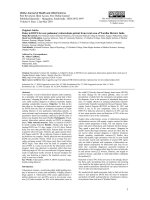Mycological profile of broncho alveolar lavage (BAL) samples in pulmonary tuberculosis patients from central India
Bạn đang xem bản rút gọn của tài liệu. Xem và tải ngay bản đầy đủ của tài liệu tại đây (351.19 KB, 7 trang )
Int.J.Curr.Microbiol.App.Sci (2019) 8(9): 2196-2202
International Journal of Current Microbiology and Applied Sciences
ISSN: 2319-7706 Volume 8 Number 09 (2019)
Journal homepage:
Original Research Article
/>
Mycological Profile of Broncho Alveolar Lavage (BAL) Samples in
Pulmonary Tuberculosis Patients from Central India
Bhawana Bajare, S. S. Tankhiwale* and S. S. Zodpey (Shrikhande)
Department of Microbiology Government Medical College, Nagpur-440003, India
*Corresponding author
ABSTRACT
Keywords
Fungal infections,
pulmonary
tuberculosis,
Branchoalveolar
lavage, Aspergillus
species, Candida
species, Central
India
Article Info
Accepted:
22 August 2019
Available Online:
10 September 2019
The frequency of fungal infections in tuberculosis patients has increased in
recent years. A study published in the Bulletin of the World Health
Organization estimates that more than a million people develop chronic
pulmonary aspergillosis after being treated for TB every year. As
bronchoalveolar lavage (BAL) fluid samples are generally useful specimens in
the diagnosis of invasive pulmonary aspergillosis (IPA), this study was
designed to evaluate the incidence of fungal infections in pulmonary
tuberculosis patients by direct microscopy and culture of BAL samples.
Material and Methods: Total 171 BAL samples from patients admitted in
department of Respiratory Medicine were received in the Department of
Microbiology subjected to microscopy and culture. Samples were processed
and identified by conventional techniques. Result: Out of 171 samples, 21
(12.28%) samples were positive in direct examination and 33(19.29%) samples
were culture positive. Candida sp were isolated in 16 (48.48%) samples,
Aspergillus sp from 14 (42.42%) samples, Fusarium sp from 2(6%) samples,
Penicillium sp from 1 (3%) sample.
develop a deadly fungal infection that is often
left untreated because it is mistaken for a
recurrence of TB.A study published in the
Bulletin of the World Health Organization
estimates that more than a million people
develop chronic pulmonary aspergillosis after
being treated for TB every year2.Candida
species are also emerging as a potentially
pathogenic fungal agent in patients with
broncho-pulmonary diseases3. A large
Introduction
Tuberculosis in India, as in other developing
countries, is a major public health problem.
Nearly 40% of the Indian population is
infected with Mycobacterium tuberculosis and
1.5-2.0% of this population is suffering from
radiological active disease1. Each year, more
than one million people who have been treated
successfully for tuberculosis (TB) go on to
1
Int.J.Curr.Microbiol.App.Sci (2019) 8(9): 2196-2202
proportion of population is suffering from
tuberculosis and around one third of
tuberculosis patients develop cavities in their
lungs, making them vulnerable to infection
with molds. Most of the time these fungal
infections are not diagnosed and often
mistaken for recurrence of tuberculosis. These
opportunistic infections if diagnosed early can
be treated effectively to prevent the
progression of disease4. So this study was
done to know the prevalence of fungal
infections among pulmonary tuberculosis
patients in this region and to identify the
common fungi causing infection in these
patients.
Hundred and ten were males (64%) and 61
(36%) were females with ages ranging from
40 to 85 years (median age being 55 years) for
both. Male preponderance were seen. Direct
microscopic examination of BAL revealed the
presence of budding yeast cells(Figure 1) and
pseudo hyphaein 11(52.38%) patients and
septate hyphae with dichotomous branching in
10(47.61)patients.
Materials and Methods
Fungal culture on SDA yielded Candida sp. in
16 (48.48%) patients, which includes C.
albicans in 7 (44%)patients, C.tropicalis in 5
(31%) patients (Figure 2), C.glabrata
in2(13%) and C.parapsilosis in 2(13%)
patients. Aspergillus sp. were isolated in 14
(42.42%) patients (Figure3), which includes A.
fumigatus in 6(43%) patients, A. flavus in
4(29%)patients, A.nidulance in 2(14%)
patients and A. niger in 2(14%) patients.
Fusarium sp were isolated from 2(6%)
patients (figure.4) and Penicillium sp from 1
(3%) patient.(Table 2)
Thus in microscopy 21/171(12.28%) were
positive
whereas
culture
reveal
33/171(19.29%) positivity. Thus adding
culture in diagnostic method we were able to
detect 12 (7%) more cases. (Table 1)
The present study was conducted on patients
infected with Mycobacterium tuberculosis on
whom the bronchoscopy was performed for
some reasons, admitted in the department of
Respiratory Medicine from July 2016 to
December
2017.
Homogenized
BAL
specimens were subjected to mycological
study by direct microscopy by making 10%
KOH mount and Gram stain. BALs were
streaked on two sets of Sabourouds Dextrose
Agar (SDA) after adding chloramphenicol
(0.05 mg/ml) and were incubated at 25 and
37°C. Species identification for yeast and
molds were done according to standard
methods of identification. Any fungal growth
was identified based on colony morphology,
pigmentation, growth rate, lactophenol cotton
blue mount (LPCB), slide culture on corn
meal agar, urease test, etc. as per conventional
techniques. For candida speciation, germ tube
test, slide culture and hi-chrome candida
chromogenic agar were used.5, 6
Though several authors have examined the
incidence of infection with specific fungal
agents in the context of chronic lung
pathology, studies on pulmonary mycoses, as
a group, have been relatively limited. In this
study we report isolation of fungi in patients
presenting with pulmonary tuberculosis in a
tertiary care teaching hospital located in the
central India.
In the present study, about 19.30%
tuberculosis patients were co infected with
fungal elements. This is in accordance with
studies conducted by Shome et al.,7 and
Babita et al.,4 who reported se 18% and 24%
cases respectively. Whereas some studies
Results and Discussion
Study group comprised of a total of 171
patients having tubercular squeals like
persisting cavity, collapse, fibrosis, etc.
2
Int.J.Curr.Microbiol.App.Sci (2019) 8(9): 2196-2202
reported higher incidence of co-infection
ranging from 36 to 39%3,8,9.This may be due
to the fact that they used sputum sample for
study of fungal infections whereas we done
our study on branchoalveolar lavage which is
more specific sample and less chances of
contamination with oral flora.
most frequent isolate,being recovered from
44% of patients, followed by Candida
tropicalis(31%) Candida glabrata (13%)and
Candida parapsilosis(13%) which is in
accordance with the studies done by Babita et
al.,4 who reported isolation of Candida
albicans in 44%. But Kali et al.,10 and Khanna
et al.,8 reported higher percentage of 50 to
62%respectively.
In present study Candida albicanswas the
Table 1. Comparison of Direct microscopy and culture
Morphology
Direct
microscopy
positive &
culture positive
Direct
microscopy
negative
& culture
positive
Total Culture
positive
(n=33)
Budding yeast
&pseudohyphae
Septate hyphae
11
5
16
10
7
17
Total= 171
21 (12.28%)
12(7%)
33(19.29%)
Fig.1
3
Int.J.Curr.Microbiol.App.Sci (2019) 8(9): 2196-2202
Fig.2
Fig.3
4
Int.J.Curr.Microbiol.App.Sci (2019) 8(9): 2196-2202
Fig.4
Fig.5
5
Int.J.Curr.Microbiol.App.Sci (2019) 8(9): 2196-2202
Fig.6
Among
Aspergillus
spp.,
Aspergillus
fumigatus was isolated in 43%samples,
followed by Aspergillusflavus29% and
Aspergillusniger14%samples.This
is
in
accordance
with
the
studies
done
byShahidetal1, Mathavi et al.,3, and Babita et
al.,4whoalso reported higher prevalence of
Aspergillus fumigatus
followed by
Aspergillus flavus and Aspergillus niger.
Aspergillus some reported common species as
A. fumigatus while others found A.flavus
species to be common. This difference in
fungal isolates may be due to the
epidemiological variations and climatic
conditions.
As more than 19% cases of serious fungal
infections are seen in treated cases of
pulmonary tuberculosis patients which may
lead to severe morbidity and mortality, a
thorough checkup of these patients for
mycosis is needed. An early suspicion and
prompt treatment will save the patients.
We also isolated Fusarium spp in2(6%)
samples. Study by Yadu, et al.,12 reported
Fusarium soloni in 6.12%patients of
pulmonary tuberculosis. One sample in
present study also yielded growth of
Penicillium sp. Similarly Wang, et al.,13and
Hatakayama. S. et al.,14 reported single case
of disseminated penicilliosis in immunocompetent tubercular person and immunocompramised tubercular patient respectively.
The present study indicates that fungal
etiology should also be sought in all the
clinically suspected pulmonary tuberculosis
patients. These secondary fungal infections are
associated with persistence of lung symptoms
in spite of successful completion of
antituberculous drug therapy. Hence adequate
measures need to be taken for the early
identification and treatment of these secondary
Most common fungal infection is found to be
Candida species by large number of workers
followed by Aspergillus species. In
6
Int.J.Curr.Microbiol.App.Sci (2019) 8(9): 2196-2202
8.
infections which are associated with high rates
of morbidity and mortality.
References
9.
1.
2.
3.
4.
5.
6.
7.
Shahid,
M.,Malik
A.,
BhargavaR.,
Secondary aspergillosis in Bronchoalveolar
Lavages(BALs) of Pulmonary Tuberculosis
Patients from North-India: AmericanEuropian Journal of Scientific Reserch2007,
2(2);97-100
Tuberculosis patients at risk of fungal
infection. />mes/89/12/11-089441.pdf
MathaviS.,ShankarR.,etal.A
study
of
mycotic infections among sputum positive
pulmonary tuberculosis patients in Salem
district. PARIPEX Indian Journal of
Research.2015 ;(4) L: 299-302.
Babita, SumanS.,Kumar P.Prevalance of
Mycotic
Flora
with
Pulmonary
Tuberculosis Patients in a Tertiary Care
Hospital.
International
Journal
of
Contemporary Medical Research2016; (3):
2563-25648.
Jagdish Chander (2012). Textbook of
Medical Mycology (3rd edition). New
Delhi, Mehta publishers.
ChakrabartiA, Shivprakash MR,Venugopal
PV, Venugopal TV. Medical Mycology
Laboratory Procedures. National workshop
in Medical Microbiology. Chennai, India:
proceeding of 29th Annual Congress of
Indian
Association
of
Medical
Microbiologist; 2005:19-20
Shome SK, Upreti HB, Singh MM and
Pamra SP (1976). Mycoses associated with
pulmonary
tuberculosis.
Ind.
J.
Tuberculosis. 23: 64-68.
10.
11.
12.
13.
14.
Khanna BK, Nath P and Ansari AH (1977).
A study of mycotic flora of respiratory tract
in pulmonary tuberculosis: Ind J
Tuberculosis. (4): 159-62.
Bansod S.,Rai M. Emerging of mycotic
infections in patients infected with
M.tuerculosis. World Journal of Med
Sci.3(2):74-80
Kali A, Charles MP, Noyal MJ, Sivaraman
U, Kumar S, Easow JM (2013). Prevalence
of Candida co-infection in patients with
pulmonary tuberculosis. Australas Med J.
6(8): 387-91.
Subhalakshmi
N.,Sivamma
B.V.,Ubbarnaidu S.S. A study of
Pulmonary Aspergillosis. IOSR Journal of
dental and medical sciences.14 (3):27-29.
Yadu R.,Nawange S.,Singh S.,Sethi R.,
Gumasta R.,Nawange M., Kavishwar A.,
Prevalance
of
opportunistic
fungal
infections in patients with pulmonary
tuberculosis in Madhya Pradesh, Central
India. Microbioz Journals, Journal of
Microbiology and Biomedical Reserch June
2015;1(6):1-12.
WangP., Wang H., and Liao C.,
Disseminated
Penicillium
marneffei
mimicking paradoxical response and
relapse in a non-HIV patient with
pulmonary
tuberculosis.
ELSEVIER,
Journal of the Chiinese Medical Association
2015(78); 258-260.
Hatakaya
S.,YanashitaT.,SakaiT.,and
Kamei K.Case Report- Disseminated
Taloromyces (Penicillium) marneffei and
Mycobacterium tuberculosis coinfection in
a Japanese Patient with Acquired
Immunodeficiency
Syndrome.
Am.J.Trop.Med.Hyg. 97(1); 2017:38-41.
How to cite this article:
Bhawana Bajare, S. S. Tankhiwale and Zodpey (Shrikhande), S. S. 2019. Mycological Profile
of Broncho Alveolar Lavage (BAL) Samples in Pulmonary Tuberculosis Patients from Central
India. Int.J.Curr.Microbiol.App.Sci. 8(09): 2196-2202.
doi: />
7

